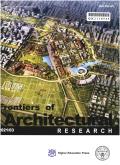Both walls and embankments: Flood control construction strategies and characteristics of Yellow River floodplain cities in the Ming Dynasty
IF 3.6
1区 艺术学
0 ARCHITECTURE
引用次数: 0
Abstract
The paper has investigated a total of 32 cities from 27 prefectures, states, and counties in Henan, Shandong, Southern Zhili, and Northern Zhili that built embankments due to the Yellow River flooding in the Ming Dynasty. It highlights the river's impact as the main driver for embankment construction, while also noting political influences on river regulation efforts. The construction of city embankments exhibits a consistent spatial and temporal distribution pattern that aligns with occurrences of river floods. The embankments are relatively low, wide and have a long slope. The materials for embankments were rammed earth generally. Various plants are planted to protect the embankments. City embankment is an important part of the flood control system in the Yellow River Floodplain, and part of urban forms. The scale is correlated positively based on the city level. The selection of sites for some cities with embankments is determined by flood avoidance strategies, consequently influencing the development pattern. The circular shape of city embankments is often influenced by both symbolic and practical considerations. The presence of large-scale water bodies surrounding cities reflects a combination of environmental changes and urban development.
城墙与堤防并重:明代黄河河漫滩城市防洪建设策略与特点
本文调查了明代河南、山东、南直隶、北直隶等地 27 个府、州、县共 32 座因黄河水患而筑堤的城市。报告强调河流的影响是筑堤的主要驱动力,同时也注意到政治因素对治河工作的影响。城池堤防的修建呈现出与河道洪水发生时间一致的时空分布模式。堤坝相对较低、较宽、坡度较长。堤坝材料一般为夯土。为保护堤坝,还种植了各种植物。城市堤防是黄河冲积平原防洪体系的重要组成部分,也是城市形态的一部分。其规模与城市级别呈正相关。一些城市堤防的选址是由避洪策略决定的,从而影响了城市的发展模式。城市堤坝的圆形通常受到象征意义和实际考虑的影响。城市周围大型水体的存在反映了环境变化和城市发展的共同作用。
本文章由计算机程序翻译,如有差异,请以英文原文为准。
求助全文
约1分钟内获得全文
求助全文
来源期刊

Frontiers of Architectural Research
ARCHITECTURE-
CiteScore
6.20
自引率
2.90%
发文量
430
审稿时长
30 weeks
期刊介绍:
Frontiers of Architectural Research is an international journal that publishes original research papers, review articles, and case studies to promote rapid communication and exchange among scholars, architects, and engineers. This journal introduces and reviews significant and pioneering achievements in the field of architecture research. Subject areas include the primary branches of architecture, such as architectural design and theory, architectural science and technology, urban planning, landscaping architecture, existing building renovation, and architectural heritage conservation. The journal encourages studies based on a rigorous scientific approach and state-of-the-art technology. All published papers reflect original research works and basic theories, models, computing, and design in architecture. High-quality papers addressing the social aspects of architecture are also welcome. This journal is strictly peer-reviewed and accepts only original manuscripts submitted in English.
 求助内容:
求助内容: 应助结果提醒方式:
应助结果提醒方式:


